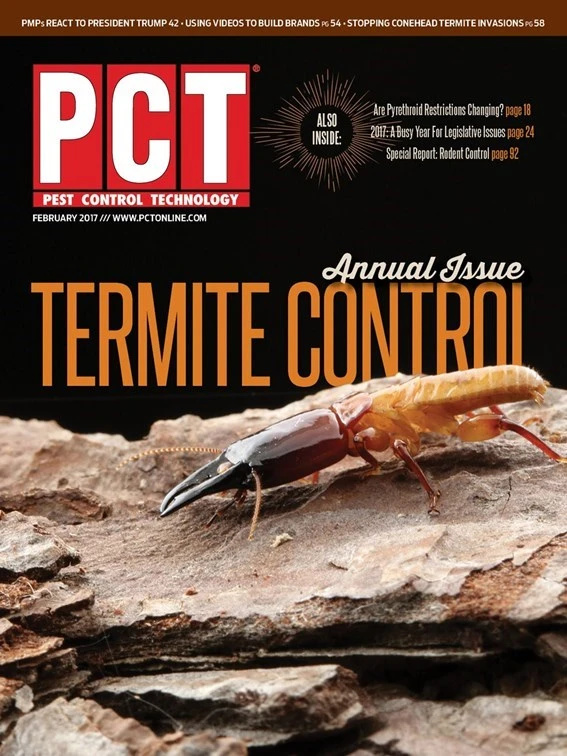
I often receive calls and emails from pest management professionals who are in affected areas about flooding from hurricanes and unusual weather conditions. The question is, “What about our termite customers in these areas that may have been flooded and experienced standing or moving water?”
To answer that question, you have to look at these floods differently than we have in the past. Ever since 1995-96, the industry as a whole has been controlling termites in a new way. In 1995, many PMPs started using baits as their primary treatment method. Later, in 1996, we were reintroduced to non-repellent termiticides.
The first non-repellent termiticide that we used was chlordane. Most of us did not know it was non-repellent and, even if we had known it, we would not have recognized what that would mean to termite control.
Termiticides are not all created equal; some will attach tightly to the soil and last for a long time if the soil is not disturbed. Organophosphates have been shown to remain in the soil for more than 35 years at some USDA test sites in Gulfport, Miss. Pyrethriods, as a general category of termiticides, also attach very well to organic matter and soil, lasting for many years. Bifenthrin may be the longest lasting, with more than 26 years of soil testing.
The unknown is the newer termiticides. Although some have been undergoing tests at USDA sites for more than 20 years, they were not designed to last in different soil types as long as older termiticides. However, some are showing residuals that may be more long lasting than was orginally thought.
WHAT ABOUT SOIL MOVEMENT? Most termiticides are stable when applied to soil, and the soil is allowed to dry. For it to be removed from a particle of sand, the termiticide would have to be subjected to a solvent or some type of chemical that would cause it to move. Normal rains with no soil movement do not cause termiticide movement.
However, flooding and heavy rains create a problem because of soil movement, not just because of the amount of water. Soil erosion may cause soil to move away, move against, or cover up foundation walls and treated vertical zones.
Standing water can create other problems, such as rot, decay, fungus and mold. Moving water brings with it sand, debris, silt and oils from roads, driveways and drain systems. These can build up around structures, covering the treated zones.
FLOODED BAITS. Baits are another story. Stand-alone bait programs do not provide a treatment barrier — or “treated zone” as we now call it — for non-repellent liquid termiticides. But baits have been subject to 20 years of field usage and, when serviced properly, get results equal to those of liquid treatments.
Flooding can bring all kinds of debris, which it can deposit on top of monitors and bait stations. This can make it difficult to locate the stations. Standing water can affect the baits that are in the stations and cause decay and mold to form on the monitor material.
Past studies have shown that water that stands for several days can greatly reduce the subterranean termite colony size, and colony redevelopment can take several years. In Formosan termite areas, downed trees and tree limbs need to be inspected for this species before they are discarded to prevent the spread of infestations to other areas.
There is no single answer on what to do after a hurricane or flood. Each situation is very different. At the very least, every structure in the affected area should be inspected and a record made of the conditions resulting from the storm. Digital pictures would be a great tool to record what was discovered at the time of the inspection.
POST-FLOOD TREATMENTS. Any treatments that are needed should not be scheduled until after repairs are made to the structure and the landscape is stabilized. Applying termiticides and installing bait systems prior to the structure being repaired and the landscape being completed would only require additional work. Soil should be dry and back to normal condition before treatment and installation of bait systems is conducted. Soil is considered to be dry when water cannot be squeezed out of it with your hands.
Bait systems that have been covered with water for any length of time may need replaced. Baits in the ground should be replaced with monitors. If the station was covered with debris that may have contained sludge, the station may need to be replaced. Monitors and missing stations that cannot be located need to be replaced in accordance with the last inspection monitoring report.
Based on history, floods and standing water problems will not kill all the termites. At best, they slow the termites down for a while, which later return with a vengeance (especially Formosan termites). That is all the more reason that pest management professionals need to get out to all of these customers and make sure their termite protection is in place. Frequent inspection is the key to termite control success.
The author is owner of JP Hardy Consulting (www.thepestcontrolexpert.com) with more than 55 years of pest control industry experience.
The authors are industry consultants and co-owners of Pinto & Associates.

Explore the February 2017 Issue
Check out more from this issue and find your next story to read.
Latest from Pest Control Technology
- Donny Oswalt Shares What Makes Termites a 'Tricky' Pest
- Study Finds Fecal Tests Can Reveal Active Termite Infestations
- Peachtree Pest Control Partners with Local Nonprofits to Fight Food Insecurity
- Allergy Technologies, PHA Expand ATAHC Complete Program to Protect 8,500 Homes
- Housecall Pro Hosts '25 Winter Summit Featuring Mike Rowe
- Advanced Education
- Spotted Lanternflies, BMSBs Most Problematic Invasive Pests, Poll Finds
- Ecolab Acquires Guardian Pest Solutions





